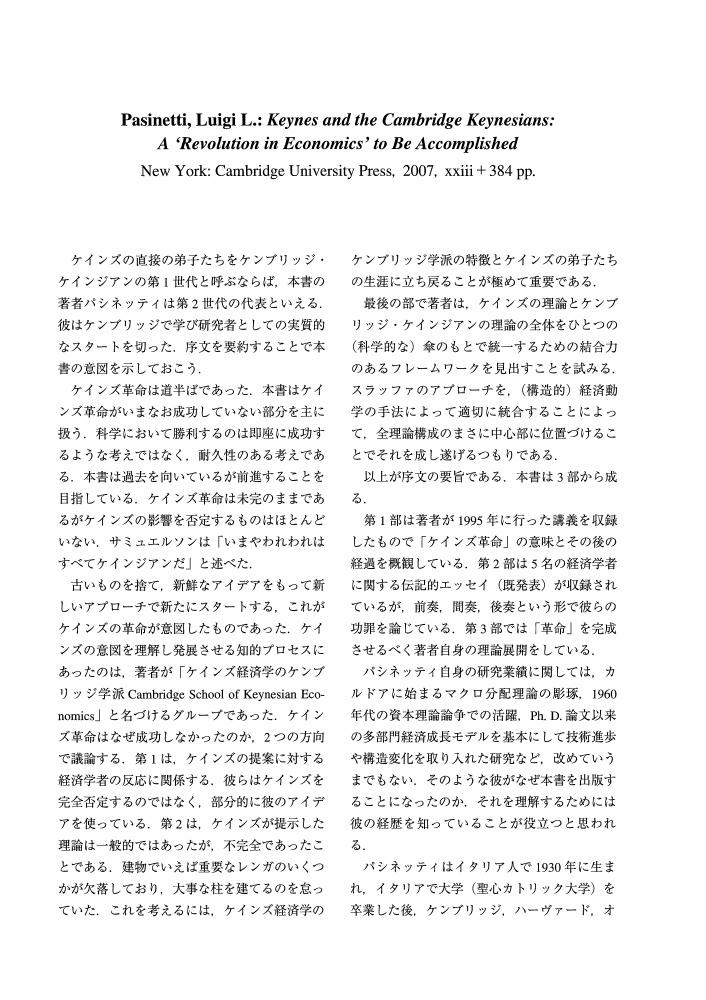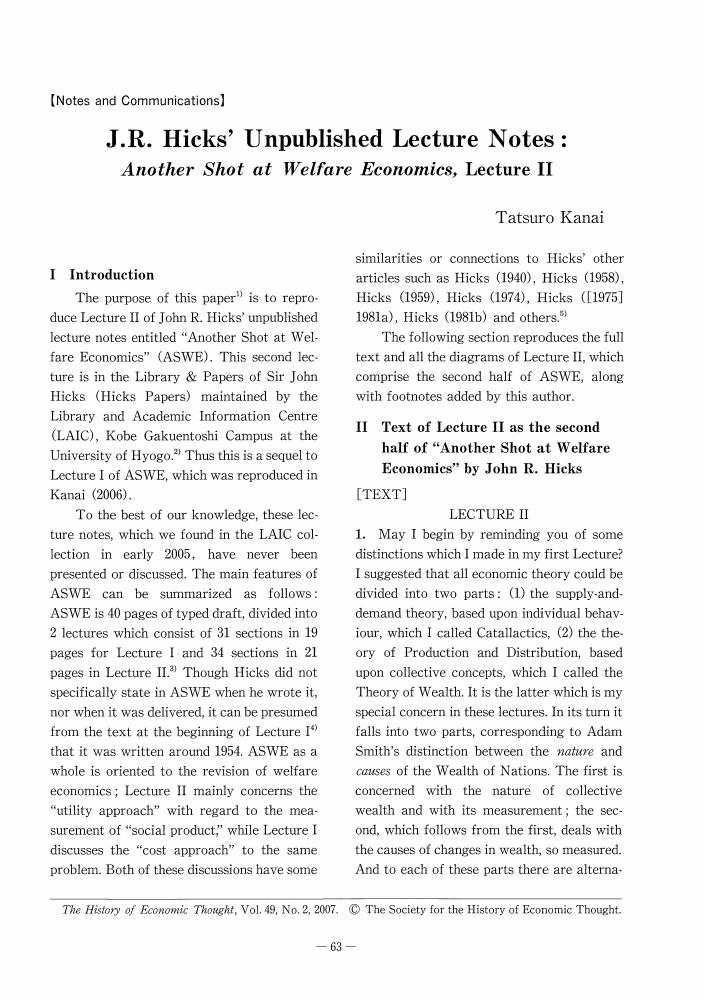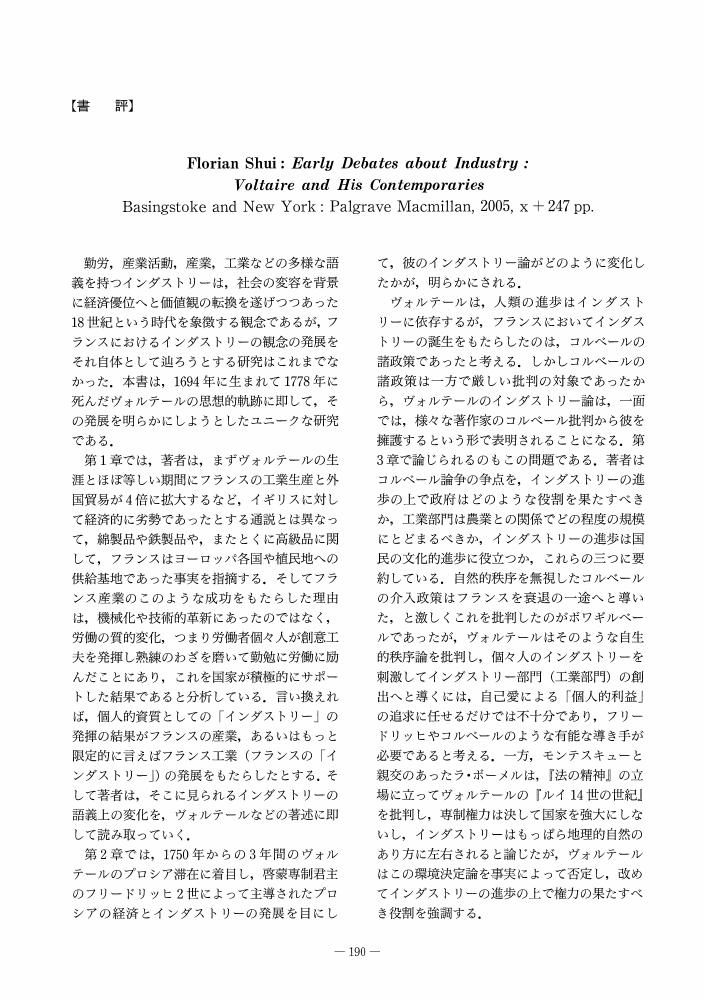- 著者
- 松本 有一
- 出版者
- The Japanease Society for the History of Economic Thought
- 雑誌
- 経済学史研究 (ISSN:18803164)
- 巻号頁・発行日
- vol.50, no.2, pp.99-100, 2009-02-05 (Released:2010-08-05)
1 0 0 0 OA Ricardo on Poverty
- 著者
- Katsuyshoi Watarai
- 出版者
- The Japanease Society for the History of Economic Thought
- 雑誌
- 経済学史研究 (ISSN:18803164)
- 巻号頁・発行日
- vol.50, no.2, pp.1-20, 2009-02-05 (Released:2010-08-05)
- 参考文献数
- 27
Ricardo's main theme was the distribution of the national product through the process of economic development, but he did not neglect the problem of poverty. He accepted Malthus's conclusions on the effects of the Poor Laws to increase poverty by stimulating population growth, and on the necessity of their repeal. In Principles, he expressed fear that the poor rates might absorb the whole surplus of the economy, because he thought the poor rates would fall on profits, which would depress the rate of real wages by retarding capital accumulation, causing more poverty. He wished to repeal the Poor Laws to establish ‘fair and free competition’ in the labour market which would improve living conditions for labourers. At the same time he recognised the need of gradual and cautious steps for their repeal, for people had formed habits of life under their influence. He showed his view on poverty in more detail in his correspondence with Huches Trower on savings banks. He saw savings banks as an important means to inculcate in the mind of the labourers prudence and spirit of independence, which he thought were essential for the repeal of the Poor Laws. For Ricardo, private charity must provide for the poverty remaining after their abolition, thus contributing to self-reliance of labourers. Transparency was important for all public activities. He did not regard combinations among labourers as interference in ‘fair and free competition.’ I will try to form an idea of his vision of the market society which he sought to establish, taking into consideration his proposal for parliamentary reform of extending franchise to all substantial householders including labourers, his conviction on sacredness of private property, his plan of a national bank to stabilise the value of money, in addition to his thoughts on poverty and its relief.
1 0 0 0 OA The German Historical School
- 著者
- Yukihiro Ikeda
- 出版者
- The Japanease Society for the History of Economic Thought
- 雑誌
- 経済学史研究 (ISSN:18803164)
- 巻号頁・発行日
- vol.50, no.1, pp.79-95, 2008-07-31 (Released:2010-08-05)
- 参考文献数
- 80
This article surveys the major secondary literature on the German Historical school produced for the most part from the 1990s onward. Following a brief introduction, and using the customary terms Older, Younger, and Youngest to identify periods of development in the school, I note with critical comment works on the Older Historical school. Then in the following section we turn to work done on the Younger and Youngest members of the School. In the last section, centering on the questions of what has been accomplished and what is necessary to promote further studies, some general suggestions are given regarding future research.
- 著者
- Natsuka Tokumaru
- 出版者
- The Japanease Society for the History of Economic Thought
- 雑誌
- 経済学史研究 (ISSN:18803164)
- 巻号頁・発行日
- vol.50, no.1, pp.100-101, 2008-07-31 (Released:2010-08-05)
- 著者
- 川又 祐
- 出版者
- The Japanease Society for the History of Economic Thought
- 雑誌
- 経済学史研究 (ISSN:18803164)
- 巻号頁・発行日
- vol.50, no.1, pp.102-103, 2008-07-31 (Released:2010-08-05)
- 著者
- 中村 隆之
- 出版者
- The Japanease Society for the History of Economic Thought
- 雑誌
- 経済学史研究 (ISSN:18803164)
- 巻号頁・発行日
- vol.50, no.1, pp.104-106, 2008-07-31 (Released:2010-08-05)
- 著者
- 岩本 武和
- 出版者
- The Japanease Society for the History of Economic Thought
- 雑誌
- 経済学史研究 (ISSN:18803164)
- 巻号頁・発行日
- vol.50, no.1, pp.107-108, 2008-07-31 (Released:2010-08-05)
1 0 0 0 OA Walker, Donald A.: Walrasian Economics New York: Cambridge University Press, 2006, x+357pp.
- 著者
- 中久保 邦夫
- 出版者
- The Japanease Society for the History of Economic Thought
- 雑誌
- 経済学史研究 (ISSN:18803164)
- 巻号頁・発行日
- vol.50, no.1, pp.109-110, 2008-07-31 (Released:2010-08-05)
- 著者
- 奥田 敬
- 出版者
- The Japanease Society for the History of Economic Thought
- 雑誌
- 経済学史研究 (ISSN:18803164)
- 巻号頁・発行日
- vol.49, no.2, pp.96-97, 2007-12-25 (Released:2010-08-05)
- 著者
- 板井 広明
- 出版者
- The Japanease Society for the History of Economic Thought
- 雑誌
- 経済学史研究 (ISSN:18803164)
- 巻号頁・発行日
- vol.49, no.2, pp.98-99, 2007-12-25 (Released:2010-08-05)
- 著者
- 米田 昇平
- 出版者
- The Japanease Society for the History of Economic Thought
- 雑誌
- 経済学史研究 (ISSN:18803164)
- 巻号頁・発行日
- vol.49, no.2, pp.100-101, 2007-12-25 (Released:2010-08-05)
- 著者
- 久保 真
- 出版者
- The Japanease Society for the History of Economic Thought
- 雑誌
- 経済学史研究 (ISSN:18803164)
- 巻号頁・発行日
- vol.49, no.2, pp.102-103, 2007-12-25 (Released:2010-08-05)
1 0 0 0 OA Russian Economic Ideas since Perestroika
- 著者
- Joachim Zweynert
- 出版者
- The Japanease Society for the History of Economic Thought
- 雑誌
- 経済学史研究 (ISSN:18803164)
- 巻号頁・発行日
- vol.50, no.1, pp.1-22, 2008-07-31 (Released:2010-08-05)
- 参考文献数
- 127
The experience of the divergent outcomes of the Central and Eastern European post-socialist transition has reminded many economists that, in the process of institutional change, ideas and ideologies matter. It may be axiomatic that today's ideas can be understood only in the context of the history of ideas, yet recent debates on ideas and institutions seldom involve any reference to the history of economic thought. Giving a detailed account of the Soviet/Russian debates on economic policy since 1987, this paper argues that the problems of establishing a market economy are difficult to appreciate without taking into account the clashes between conflicting patterns of thought that are deeply rooted in the Soviet and pre-Soviet history of Russian economic ideas.
1 0 0 0 OA J. A. ホブスンのレント論の再構成
- 著者
- 大水 善寛
- 出版者
- The Japanease Society for the History of Economic Thought
- 雑誌
- 経済学史研究 (ISSN:18803164)
- 巻号頁・発行日
- vol.50, no.1, pp.41-61, 2008-07-31 (Released:2010-08-05)
- 参考文献数
- 64
This paper attempts to reinterpret Hobson's theory of rents and highlight the strong relevance of his theory of rents to the central objectives of New Liberalism in the late 19th and early 20th century as economic activity shifted from laissez-faire competition to monopoly capitalism. In the same period, among the four economists-Sydney Webb, John B. Clark, J. A. Hobson, and Alfred Marshall-who formulated distinct theories of rent, Hobson stands out from the others in the consistency and breadth of his theory. All his ideas for social reform were put forward on the basis of that theory, and his optimistic view of the potential for economic development offered by capitalism can be attributed to his belief that political reforms would secure non-monopolistic and fair distribution of wealth.The three analytical dimensions and concepts in Hobson's rents theory are rent, gain, and surplus. Rent refers to the whole income accruing from the factors of production, and it is divided into three parts: marginal rent is necessary to maintain a minimum standard of living and productive capacity; differential rent is directly or indirectly necessary to enhance the standard of living and productive capacity; and forced rent is the outcome of squeeze and exploitation by monopolistic powers, thus precluding the means to increase the standard of living and productive capacity of the society. Although these definitions of rent are clear enough when they are used in abstract economic theory, they differ considerably from the common usages of “rent.” That is because Hobsonian “rents” include, in part, even the wages of labor and profits of capital.Compared with his formulation of rents, Hobson's concept of gain is closer to the way the term is commonly used to understand and explain behaviors and intentions of laborers, capitalists, and landowners. In the dimension of gain, consequently, differential rent is identical to differential gain, and forced rent is identical with forced gain. The concept of gain is nothing but an explanatory device.The idea and theory of surplus essentially fall into the realm of policy and political theory, but “surplus” is accepted as an original and core concept in Hobson's economic analysis. It is, however, so complex that we must initially distinguish between two definitions of the term. First, surplus derives from rent and gain, therefore, it is equal to forced rent and forced gain. Second, surplus is calculated on the basis of cost, and so it is equal to price over cost. The latter definition is further subdivided into productive surplus (differential gain and rent) and unproductive surplus (forced gain and rent). In that sense, surplus consists substantially of differential and forced gain, that is, differential and forced rent.Then, it will be safe to say that unequal distribution of wealth due to productive surplus can contribute and accelerate economic progress, while unequal distribution of wealth due to unproductive surplus will not. Thus Hobson had to advocate a liberal policy for increasing productive surplus (differential gain and rent) on the one hand, and a restrictive policy for decreasing unproductive surplus (forced gain and rent) on the other. Viewing Hobson's thinking in that perspective, we can see that his policy proposals for curing the maldistribution of wealth are consistent with the advocacy by New Liberalism of both liberal and restrictive policies at the same time in the project to promote general social welfare at that time.
- 著者
- Tatsuro Kanai
- 出版者
- The Japanease Society for the History of Economic Thought
- 雑誌
- 経済学史研究 (ISSN:18803164)
- 巻号頁・発行日
- vol.49, no.2, pp.63-78, 2007-12-25 (Released:2010-08-05)
- 参考文献数
- 18
- 著者
- 伊藤 宣広
- 出版者
- The Japanease Society for the History of Economic Thought
- 雑誌
- 経済学史研究 (ISSN:18803164)
- 巻号頁・発行日
- vol.49, no.2, pp.94-95, 2007-12-25 (Released:2010-08-05)
- 著者
- 柳田 芳伸
- 出版者
- The Japanease Society for the History of Economic Thought
- 雑誌
- 経済学史研究 (ISSN:18803164)
- 巻号頁・発行日
- vol.49, no.1, pp.186-187, 2007-06-30 (Released:2010-08-05)
- 著者
- 佐々木 憲介
- 出版者
- The Japanease Society for the History of Economic Thought
- 雑誌
- 経済学史研究 (ISSN:18803164)
- 巻号頁・発行日
- vol.49, no.1, pp.188-189, 2007-06-30 (Released:2010-08-05)
- 著者
- 米田 昇平
- 出版者
- The Japanease Society for the History of Economic Thought
- 雑誌
- 経済学史研究 (ISSN:18803164)
- 巻号頁・発行日
- vol.49, no.1, pp.190-191, 2007-06-30 (Released:2010-08-05)
- 著者
- 御崎 加代子
- 出版者
- The Japanease Society for the History of Economic Thought
- 雑誌
- 経済学史研究 (ISSN:18803164)
- 巻号頁・発行日
- vol.49, no.1, pp.192-193, 2007-06-30 (Released:2010-08-05)















